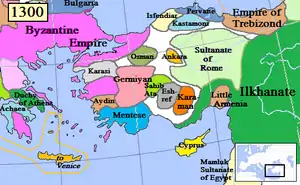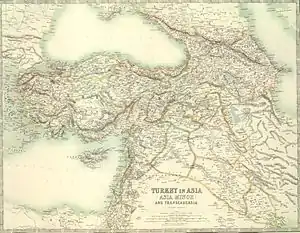Menteshe
Mentese (Ottoman Turkish: منتشه, Turkish: Menteşe) was the first of the Anatolian beyliks, the frontier principalities established by the Oghuz Turks after the decline of the Seljuk Sultanate of Rum. Founded in 1260/1290, it was named for its founder, Menteshe Bey ("bey" is a title that indicates a tribal chieftain). Its capital city was Milas (Mylasa) in southwestern Anatolia.[1]

Part of a series on the |
|---|
| History of Turkey |
 |
|
|
The heartland of the beylik corresponded roughly to ancient Caria or to the early modern Muğla Province in Turkey, including the province's three protruding peninsulas. Among the important centers within the beylik were the cities of Beçin, Milas, Balat, Elmali, Finike, Kaş, Mağrı (modern Fethiye), Muğla, Çameli, Acıpayam, Tavas, Bozdoğan, and Çine. The city of Aydın (formerly Tralles) was controlled by this beylik for a time, during which it was called "Güzelhisar"; it later was transferred to the Aydinids in the north, who renamed the city for the founder of their dynasty.
The Beylik of Mentese were serious regional naval powers of their time.[2] They were sometimes referred to as the Sea Turks as they were the first seafaring Beylik. The Beylik produced fine boats using special trees harvested from the expansive forests in the high coastal mountains. These boats sailed well and were well built and the models for today's Gulet Sailboats, which are prevalent in the Aegean Sea in both Greece and Turkey. The Beylik even conquered Rhodes and many other islands, which are still referred to as the "Mentese" Islands or The Dodecanese. During the Siege of Constantinople in 1453, approximately 40% of the Ottoman Navy was from the Mentese Beylik. Today, the present-day Mugla continues to be a major shipbuilding region where many luxury mega yachts are now produced for export. With the modern-day resorts of Bodrum, Gocek, Marmaris, and Fethiye, the Mentese Beylik is a beautiful region with year-round good weather. The climate is Warm/Mediterranean.
Architecturally, the Mentese Beylik had a significant impact on later Ottoman Architecture. They were the first Beylik to construct large precision cut stone buildings and became experts in building domes and archways. The region itself was a important source of marble and stone since the Roman times and continues to be Turkey's top stone export region. They also left important works of architecture, such as the Firus Bey Mosque in Milas and İlyas Bey Mosque in Balat.
Menteşe Bey first submitted to Ottoman rule in 1390, during the reign of Bayezid I, "the Thunderbolt".[3] After 1402, Tamerlane restored the beylik to Menteşoğlu İlyas Bey, who recognized Ottoman overlordship in 1414. A dozen years later, in 1426, Mentese was incorporated into the Ottoman realm.[4]
The present-day Muğla Province of Turkey was named the sub-province (sanjak) of Menteshe until the early years of the Republic of Turkey, although the provincial seat had been moved from Milas to Muğla with the establishment of Ottoman rule in the 15th century.
Today the descendants of the Mentese Beylik Dynasty live mainly in Turkey's largest cities such as Izmir or Istanbul. Several also live abroad in California and the United Kingdom. In the last several decades, many have returned to the Mentese Beylik (Modern day Mugla Provence in Turkey) and settled in resort towns such as Yalikavak, Bodrum, Gocek, Marmaris and Fethiye.
See also
- Mesut Bey of Menteşe
- List of Sunni Muslim dynasties
References
- Claude Cahen, Pre-Ottoman Turkey: A General Survey of the Material and Spiritual Culture and History, c. 1071-1330, 1968 (New York: ACLS Humanities, 2014), p. 308
- Hans Theunissen. "Venice and the Turkoman Begliks of Menteşe and Aydın" (PDF). Leiden University. Archived from Chapter V of Ottoman-Venetian diplomatics, the Ahd-Names the original Check
|url=value (help) on 2005-04-29. - Stanford Shaw, History of the Ottoman Empire and Modern Turkey (Cambridge: University Press, 1976), vol. 1 p. 30
- Shaw, History of the Ottoman Empire, p. 44
Sources
- Wittek, Paul (1934). Das Fürstentum Mentesche. Studien zur Geschichte Westkleinasiens im 13.-15. Jahrhundert (in German). Istanbul: Zaman Kitaphanesi.CS1 maint: ref=harv (link)
- Zachariadou, Elisabeth A. (1983). Trade and Crusade: Venetian Crete and the Emirates of Menteshe and Aydin (1300-1415). Venice: Istituto Ellenico di Studi Bizantini e Post-bizantini di Venezia. OCLC 144691037.CS1 maint: ref=harv (link)
